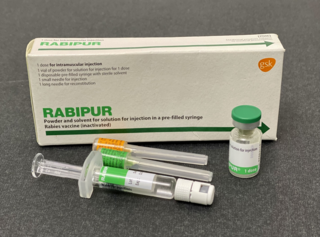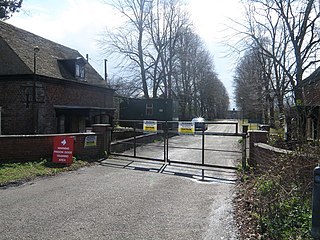
Bluetongue disease is a noncontagious, insect-borne, viral disease of ruminants, mainly sheep and less frequently cattle, yaks, goats, buffalo, deer, dromedaries, and antelope. It is caused by Bluetongue virus (BTV). The virus is transmitted by the midges Culicoides imicola, Culicoides variipennis, and other culicoids.

The smallpox vaccine is the first vaccine to have been developed against a contagious disease. In 1796, British physician Edward Jenner demonstrated that an infection with the relatively mild cowpox virus conferred immunity against the deadly smallpox virus. Cowpox served as a natural vaccine until the modern smallpox vaccine emerged in the 20th century. From 1958 to 1977, the World Health Organization (WHO) conducted a global vaccination campaign that eradicated smallpox, making it the only human disease to be eradicated. Although routine smallpox vaccination is no longer performed on the general public, the vaccine is still being produced to guard against bioterrorism, biological warfare, and mpox.

Pirbright is a village in Surrey, England. Pirbright is in the borough of Guildford and has a civil parish council covering the traditional boundaries of the area. Pirbright contains one buffered sub-locality, Stanford Common near the nation's farm animal disease research institute. The village's grade II* listed medieval church has a large Boulder grave for explorer Henry Morton Stanley. The nearby Hodge Brook is marked as Congo Stream, between Ruwenzori and Stanley Hills.
Biotechnology and Biological Sciences Research Council (BBSRC), part of UK Research and Innovation, is a non-departmental public body (NDPB), and is the largest UK public funder of non-medical bioscience. It predominantly funds scientific research institutes and university research departments in the UK.
The Edward Jenner Institute for Vaccine Research (EJIVR) was an independent research institute named after Edward Jenner, the inventor of vaccination. It was co-located with the Compton Laboratory of the Institute for Animal Health on a campus in the village of Compton in Berkshire, England. After occupying temporary laboratory space at the Institute for Animal Health from 1996, the Institute moved to a newly completed laboratory building in 1998. Funding of the Institute continued until October 2005 when it was closed.
Walter Plowright CMG FRS FRCVS was an English veterinary scientist who devoted his career to the eradication of the cattle plague rinderpest. Plowright received the 1999 World Food Prize for his development of tissue culture rinderpest vaccine (TCRV), the key element in the quest to eliminate rinderpest. Rinderpest became the first animal disease to be eliminated worldwide.

Boehringer Ingelheim Animal Health is a multinational animal health company, formed in January 2017 when Merial was acquired by Boehringer Ingelheim and merged with Boehringer Ingelheim's existing animal health assets.

The 2007 United Kingdom foot-and-mouth outbreak occurred when the discharge of infectious effluent from a laboratory in Surrey led to foot-and-mouth disease (FMD) infections at four nearby farms. The infections were detected via regular livestock testing by the Department for Environment, Food and Rural Affairs (Defra).
Deborah Reynolds CB served as the Chief Veterinary Officer (CVO) of the United Kingdom from March 2004 until she retired in November 2007. She is usually referred to as Debby Reynolds, or less often as Deborah Reynolds.

The rabies vaccine is a vaccine used to prevent rabies. There are several rabies vaccines available that are both safe and effective. Vaccinations must be administered prior to rabies virus exposure or within the latent period after exposure to prevent the disease. Transmission of rabies virus to humans typically occurs through a bite or scratch from an infectious animal, but exposure can occur through indirect contact with the saliva from an infectious individual.

Foot-and-mouth disease (FMD) or hoof-and-mouth disease (HMD) is an infectious and sometimes fatal viral disease that affects cloven-hoofed animals, including domestic and wild bovids. The virus causes a high fever lasting two to six days, followed by blisters inside the mouth and near the hoof that may rupture and cause lameness.
Dr. Simon Carpenter, Head of the Entomology and Modelling Group in the Vector-borne Diseases Programme at the UK Biotechnology and Biological Sciences Research Council Institute for Animal Health’s Pirbright Laboratory in Woking, Surrey, is an entomologist who was awarded the first Rooker Prize in 2009 in recognition of his research on biting midges that transmit bluetongue virus (BTV), the causative agent of bluetongue disease, an important orbivirus disease of ruminants.

The Roslin Institute is an animal sciences research institute at Easter Bush, Midlothian, Scotland, part of the University of Edinburgh, and is funded by the Biotechnology and Biological Sciences Research Council.
The National Centre for Foreign Animal Disease (NCFAD), located in the Canadian Science Centre for Human and Animal Health in Winnipeg, Manitoba, is part of the Canadian Food Inspection Agency’s National Centres for Animal Disease. NCFAD is co-located with the Public Health Agency of Canada’s National Microbiology Laboratory.
Polly Roy OBE is a professor and Chair of Virology at The London School of Hygiene and Tropical Medicine. She attended a number of schools which included Columbia University Medical School, Rutgers University, University of Alabama, and University of Oxford. In 2001 she became a part of The London School of Hygiene and Tropical Medicine and, along with being the chair of Virology, is also the co-organiser of the medical microbiology course. The virus that she has dedicated most of her career to is Bluetongue disease that affects sheep and cattle. She became interested in this virus after attending a symposium and was intrigued by the fact that not much was known about the virus that was causing such a nasty and sometimes fatal disease.
John Burns Brooksby was a Scottish veterinarian, animal physiologist and veterinary virologist. He was a recognised expert on serology and especially foot-and-mouth disease, and identified and categorised the majority of its known forms. His advice was taken on an international level, and he played a significant role in disease control in Africa and the Middle East.
Gopal Dhinakar Raj is an Indian veterinary scientist, an academic and the project director of the Translational Research Platform for Veterinary Biologicals, a partnership program between the Department of Biotechnology and the Tamil Nadu Veterinary and Animal Sciences University. Known for the development of diagnostic test kits for animal and poultry diseases such as Leptospirosis and Egg drop syndrome, Raj is a member of the DBT Task Force on Animal Biotechnology. The Department of Biotechnology of the Government of India awarded him the National Bioscience Award for Career Development, one of the highest Indian science awards, for his contributions to biosciences in 2007.

The Jenner Institute is a research institute on the Old Road Campus in Headington, east Oxford, England. It was formed in November 2005 through a partnership between the University of Oxford and the UK Institute for Animal Health. It is associated with the Nuffield Department of Medicine, in the Medical Sciences Division of Oxford University. The institute receives charitable support from the Jenner Vaccine Foundation.

The Houghton Poultry Research Station was a poultry disease research station in northern Cambridgeshire.
The National Veterinary Research Institute (NVRI)is a research institute in Nigeria that was established in 1924 and has the mandate to conduct research into how to ably identify, treat and control animal diseases as well as the development of vaccines for such and training and the provision of support services to livestock and poultry farmers. The institute is under the supervision of Federal Ministry of Agriculture and Rural Development. The chief executive is Maryam Muhammad, a veterinary doctor with research interests in the molecular epidemiology of Salmonella in poultry, public health and environment and development.










